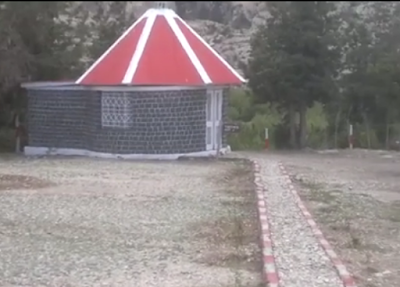
Zizri is one of the most beautiful valleys of Ziarat. This valley possesses a breathtaking beauty.The valley has very large and some of the oldest Juniper trees. It has untouched natural beauty which make it unique from other valleys of Ziarat..
Zizri valley at a distance of about 12 kms from Ziarat town. It located at an elevation of 2,250 m above sea level. It is situated on the southern edge of the Ziarat It is mostly mountainous area with thick juniper forest, wild flowers and many herb plants.
Zezri valley is accessible from Ziarat. The route goes through Prospect Point . The drive from prospect point is quite picturesque and the road passes through a thick Juniper forest with occasional glimpses of the valleys down below.The road is shingle and rough from Prospect Point to the Zizri valley.


The black top road from the Quaid -e -Azam Residency goes to Prospect Point. It turn off at Green Juniper Restaurant to descend into Trang Nala. Climbing up, attain the jeep road to Kili Sardaran, home of the chief of the Sarangzai clan of Kakars.Leaving the village to your right, enter the juniper-covered plateau of Bar Maghzi, at the far end of which the trail descends into the dry gorge of Loi Ghat. The barely visible trail climbs to Ismail Maghzi before leading to Orazhe Sar, the highest point, from where it is downhill all the way to Zizri. To the east is the sheersided 3,485 m cone of Khalifat, Passing the landmarks of the bleached white Spin (White) Maghzi and the knob of reddish brown rock called Tor Skhar (Black Rock), one attains the concrete pond of Gharrai beyond which lie the fields of Zezri. The fields and orchards of Zizri lie on a short walk away.

Zizri valley has significant importance because it lies in the base of Khalifat mountain. This mountain is the highest mountain of Ziarat and the second highest of Balochistan located in Suleiman mountain range. . Zizri is located on the north east side of Khalifat peak. Zizri valley provide leading route to khilafat peak. The route from the valley goes into the forest along the eastern edge of the Khalifat peak. After crossing the forest, towards right direction one has to enter a narrow slide which ends in a sheer fall to the right and a rock wall to the left.
The panorama view of this valley is so impressive.which make it a unique and distinctive. Juniper trees found in this valley are mostly straight and high with trunks measuring some six metres make it a picturesque valley. The contrast of yellowish rock,with the green juniper trees that grow among the rocks and on the valley floor make it so amazing.

The valley provides quiet and picturesque escape for nature lovers with high rocky walls dotted with Junipers surrounding .,There are many varieties of birds and the chirping sound of birds make it a perfect natural and pristine place.The juniper forest ecosystem of zizri valley provides habitat for endangered wildlife species and supports a rich diversity of plant species There are found some wild species including Suleiman Markhor, Urial, Black Bear and Wolf.
 |
Green Domes in Zizri valley
The aromatic ziziphora, used as a remedy for colds and influenza, is also abundant here, spread over the valley floor like a green carpet. Especially during the rainy season, the fragrance of this medicinal plant spread all over the valley be missed. There are also wild olive,forest in this valley.
|

Development Authority of the district government had constructed Huts which is for the purpose if the weather gets too unbearable.than to take refuge in The beautiful huts are unique with there conical designs with red roof. These huts has surrounding lawn with children play area and with few swings. A constant aroma comes from the forest. It is a serene place surrounded with contrast of grey mountains and juniper tress. It is base and from here the Zizri valley and surrounding forest can be explored. This place offers a spectacular view of the mountainous area surrounded it Khalifat peak is seen from here
The entire area of Zizri valley is worth visiting for its lush green natural beauty, its enchanting juniper forests with Some of the trees which are almost 4,000 to 7000 years old, mountain peaks,The area is refreshingly cool in summer
Zizri valley with the juniper around offer good opportunity hiking and trekking. Camping is recommended to enjoy the nature
The Zizri valley is good for a day trip and for camping.
The best time to visit Zizri valley is between May to August when the temperature is in comfortable ranges. It is refreshingly cool in summer, It is extremely cold in winters and gets a heavy snowfall.
The Spring season is in April The summer season is from May to August. It starts getting cold in September and from November to March.it is winter.
******************************************

























































